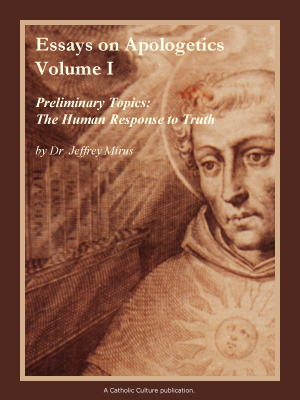Catholic World News News Feature
The beatification process: What lies ahead for John Paul's cause? June 28, 2005
The cause for the beatification of Pope John Paul II will formally be opened on June 28. What lies ahead?
Pope John Paul himself strongly believed that the Church should offer the saints as models of Christian witness, for the faithful to imitate. During his 26-year pontificate he presided over an enormous expansion in the number of people recognized by the Church as saints. He personally beatified 1,342 people, and canonized 483 saints-- more than matching the total number of people beatified (1,201) and canonized (302) in the years between 1588, when the procedures for recognizing saints were established, until the beginning of his pontificate.
Pope John Paul also inaugurated a simpler procedure for the recognition of saints, and today the Congregation for the Causes of Saints is swamped with work. There are nearly 2,000 formal "causes"-- or investigations-- already open, and petitions arrive every day for the opening of new causes.
However, the cause of Pope John Paul is certain to receive special attention. Although the formal procedures require a wait of 5 years after the death of a candidate before a cause can be opened, the late Pontiff set a precedent when he waived that waiting period in the case of Blessed Teresa of Calcutta. Pope Benedict XVI took the same step when, on May 13, he announced that he would waive the 5-year requirement for his predecessor, allowing the process to begin immediately.
The cause is likely to proceed quickly, but an enormous amount of work remains to be done before the beatification of the late Pope is possible. Archbishop Stanislaw Dziwisz of Krakow, the longtime secretary to the deceased Pope, has confessed that he cherishes the "dream" that Pope Benedict could pronounce the beatification in August, when he visits Cologne for World Youth Day. But the Polish prelate admits that this is an unrealistic hope.
The process toward beatification begins with an investigation into the candidate's life and conduct, carried out by officials of the diocese in which he died-- in the case of Pope John Paul, the Rome diocese. This investigation is designed to provide evidence that the candidate lived a life of "heroic virtue." In the process, investigators are expected to examine all of the public actions, speeches, and writings of the candidate; in the case of Pope John Paul, this will be an exhausting task.
The procedures leading up to beatification and canonization have changed considerably over the years. For centuries, the Church recognized saints simply on the basis of popular devotion. Many Catholics in Italy-- particularly the lay movement Foccolari-- called for a return to that tradition in the case of John Paul II. The cries of Santo Subito that rang out across St. Peter's Square during his funeral testified to the belief that the beloved Pope should be beatified quickly, because the universal acclaim for his life and work was sufficient evidence of his virtue.
During the period between the death of John Paul II and the conclave that elected Benedict XVI, many cardinals threw their support behind the campaign for quick beatification. When Cardinal Camillo Ruini presented that request to Pope Benedict on May 9, he promptly agreed.
Up until the 11th century, saints were regularly proclaimed by individual bishops, with no intervention by the Pope. The Vatican gradually imposed a monopoly on the process of declaring saints, however, and by the 18th century the process leading up to canonization was fixed. In 1983, in reforming and simplifying the process, Pope John Paul returned a substantial portion of the authority to diocesan bishops, who supervise the initial investigation into a candidate's life and virtue. Before the reforms of 1983, the process of beatification involved a sort of contest between the promoters of the cause and the "devil's advocate," who was charged with raising every possible objection and examining any evidence that could weigh against the candidate's reputation for sanctity. With his apostolic constitution Divinus Perfectionis Magister , John Paul II simplified the process, gave greater importance to the compilation of a historical record, and made it possible to complete the requirements for beatification quickly. The process remains a lengthy one, however, typically lasting dozens of years. Pope John Paul believed that the process remains too lengthy, and many officials at the Congregation for the Causes of Saints agree. Because a cause may continue beyond the lifespan of those who knew the candidate personally, the research becomes more difficult, and enthusiasm often wanes as the supporters of the candidacy die. For that reason, and because investigations involve some costly research, most of the current causes pending before the Vatican involve religious, whose causes are supported by the members of their congregations.
On the other hand, some critics objected that the Vatican had become a "canonization factory" under John Paul II, and suggested that fewer saints should be formally proclaimed. Cardinal José Saraiva Martins, the current prefect of the Congregation for the Causes of Saints, rejects that charge. The investigation that leads up to beatification and canonization remains rigorous, he points out. As for the proliferation of saints, the cardinal argues that it is healthy for the Church to set out a variety of models for imitation, showing the "complete diversity of heroes in Christian holiness."
Pope John Paul II had strongly championed the argument that canonization should not be seen as a privilege reserved for the clergy and religious. The Church needs models of sanctity in everyday life, he consistently argued. He did not hesitate to proclaim the sainthood of people whose lives were characterized not by extraordinary acts, but by a simple and consistent piety, in which they "applied the Gospel daily, in a coherent and concrete manner."
The large number of people beatified in recent years, Pope John Paul remarked in 1994, shows "the action of the Holy Spirit and the vitality he provides" to the Church. He also argued that the "young churches" in distant countries need their own models for sanctity. Most of the saints recognized by the Church to date have been Europeans, and nearly half of the current candidates are Italian.
Each of the officials appointed to serve in the investigation of a cause must take an oath that he will, among other things, "accept no gift" in connection with the process. Nevertheless, the investigation itself is a costly affair, involving the research and preparation of extensive dossiers. In the case of Blessed Padre Pio, the position-- the dossier sent to the Vatican at the conclusion of the diocesan investigation-- ran to 1,500 pages; 50 copies must be produced. The testimony collected during the investigation is also collated, routinely amounting to dozens of volumes. A typical process for beatification can involve expenditures of $60,000. In the case of Pope John Paul-- whose pontificate produced vast quantities of written material, and whose candidacy has already produced testimony from thousands of witnesses-- the costs will be considerably higher.
New expenditures are required when the cause reaches the point of beatification. The lay people involved in the investigation-- such as the doctors who are called upon to testify to the validity of a miracle-- must be paid for their work. And while the Vatican organizes the actual ceremonies for beatification, the organizers of the cause are expected to provide for the costs. The canonization of St. Josemaria Escriva, the founder of Opus Dei, involved expenditures of more than $350,000. If Pope John Paul eventually reaches the stage of canonization, he will join many other popes formally recognized as saints. All of the first 53 pontiffs, from St. Peter through St. Gelasius I (492- 496), are now canonized. The last Pope canonized was Pius X, who was proclaimed a saint by Pope Pius XII in 1954. Pope John Paul himself beatified both Pius IX (1846- 1878) and John XXIII (1958- 1963). And causes are now open for the beatification of Pius XII, Paul VI, and John Paul I.






